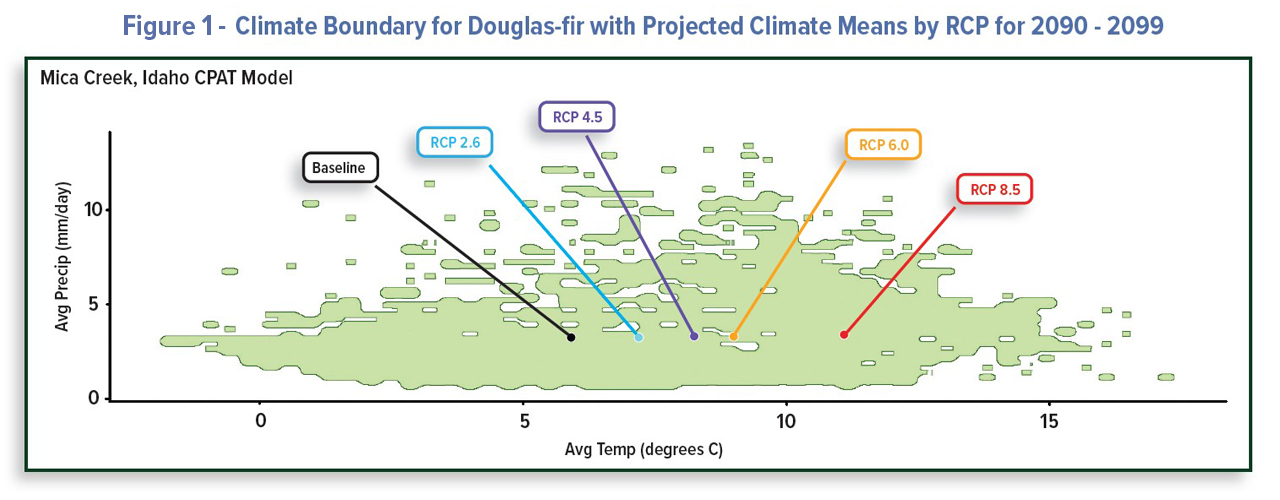NORTHAMPTON, MA / ACCESSWIRE / January 24, 2024 / PotlatchDeltic’s timberland climate analysis evaluates the potential physical impacts that changes in atmospheric CO2, temperature, and precipitation could have on our timberlands under various greenhouse gas (GHG) scenarios. We have evaluated potential physical impacts on our Idaho timberlands utilizing guidance from the Task Force on Climate-related Financial Disclosures (TCFD) and using the National Council for Air and Stream Improvement (NCASI) Climate Projection Analysis Tool (NCASI Climate Tool). Following TCFD guidance, we evaluated four Representative Concentration Pathways (RCPs) or sets of potential future scenarios, including a highly unlikely, high consequence scenario: RCP 2.6, RCP 4.5, RCP 6.0, and RCP 8.5.
Temperature projections for our northern Idaho region were modeled using the NCASI Climate Tool under the four RCPs. Using RCP 2.6, downscaled temperature projections for the region reveal a temperature increase of about 0.5°C from the 2020’s to the 2040’s with no additional increase through the rest of the century. RCP 4.5 shows a temperature increase of approximately 0.7°C from the 2020’s to the 2040’s with an additional increase of roughly 1.0°C expected through the rest of the century. Similarly, RCP 6.0 shows a temperature increase of about 0.6°C from the 2020’s to the 2040’s with an additional increase of approximately 2.0°C through the rest of the century. RCP 8.5 shows a steady increase of roughly 4.4°C between the 2020’s and the end of the century. Precipitation projections for northern Idaho using the NCASI Climate Tool do not vary meaningfully by RCP and all four pathways project a very gradual increase of 5-15% from 2020 to 2100. Increases tend to be greater at higher elevations on the northern portion of our ownership and lower on the southern, low-elevation lands.
Douglas-fir accounts for approximately 60% of the seedlings planted on our Idaho timberlands. The species grows best in full sun or partial shade and prefers acidic or neutral soil that is well drained. It is moderately drought resistant and less prone to insects and disease than other coniferous species. Downscaled RCP projections for northern Idaho indicate annual climatic conditions are projected to be well suited for growth and productivity through the 2060 decade, which provides a full growing cycle until 2100.
Our climate boundary analysis for Douglas-fir illustrates that the projected range of temperature and precipitation should be suitable for its growth under all RCP scenarios through 2100. See Figure 1. In addition, the current range of Douglas-fir in the US extends into Colorado, Arizona and New Mexico suggesting that it can survive in conditions found at latitudes well south of Idaho.
The analysis for Douglas-fir productivity arising from a combination of temperature and precipitation under various RCP scenarios in 2090-2099 illustrates that conditions remain favorable for Douglas-fir and loss of productivity is not projected. See Figure 2.
Higher elevations in Idaho are projected to warm relatively more than lower elevations and to have rising snowlines. This may improve higher elevation growth rates by lengthening the growing season and increasing the number of growing degree days. Lower elevation sites in Idaho with south and west facing slopes located on the western fringe of our Idaho timberlands may have a risk of increasing water stress.
Increased frequency, duration, or intensity of droughts in Idaho may increase wildfire risk and increase variability in annual planting success and could result in increased casualty losses or higher forest management expenses. Increased risks from insects and disease primarily result from overcrowding, decadent forest conditions and the chance of severe outbreaks are significantly increased by drought and moisture stress.
Overall, the projections for northern Idaho indicate annual climatic conditions should be well suited for Douglas-fir growth and productivity through the 2100 decade. Long term changes in climatic conditions in Idaho are likely to be variable and growth rates for different tree species may increase or decrease. Elevation, aspect, and soil characteristics are all likely to interact with long term climate changes to determine net growth rate changes.
FORWARD-LOOKING STATEMENTS
This release contains certain forward-looking statements within the meaning of the federal securities laws. Projections of future climate conditions based on modeling of greenhouse gas scenarios, as well as their effects on tree growing conditions, are inherently forward-looking and subject to change. Words such as "likely," "chance," "could," "long term," "may," "potential," "projected," "should," "suggested," "unlikely," and similar expressions and references to achievement of objectives in the future are intended to identify such forward-looking statements. These statements reflect management’s views of future events based on estimates and assumptions and are therefore subject to known and unknown risks, uncertainties, and other factors, and are not guarantees of future conduct, results, or policies. Please view the Cautionary Statement Regarding Forward-Looking Information on page 30 of PotlatchDeltic’s 2022 Carbon and Climate Report.

View additional multimedia and more ESG storytelling from PotlatchDeltic on 3blmedia.com.
Contact Info:
Spokesperson: PotlatchDeltic
Website: https://www.3blmedia.com/profiles/potlatchdeltic
Email: [email protected]
SOURCE: PotlatchDeltic
View the original press release on accesswire.com
